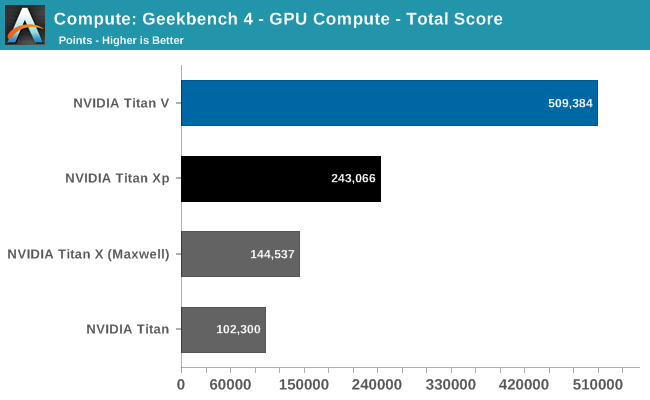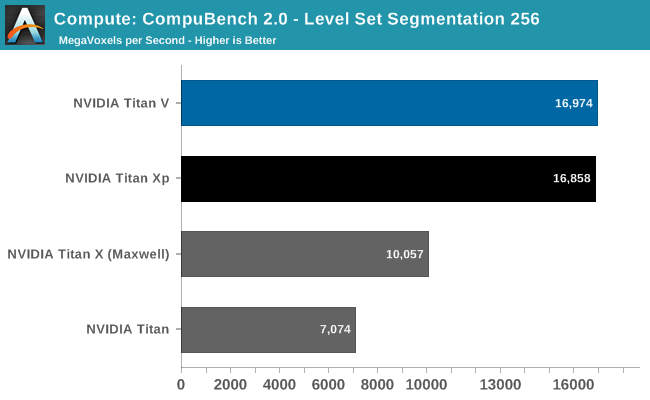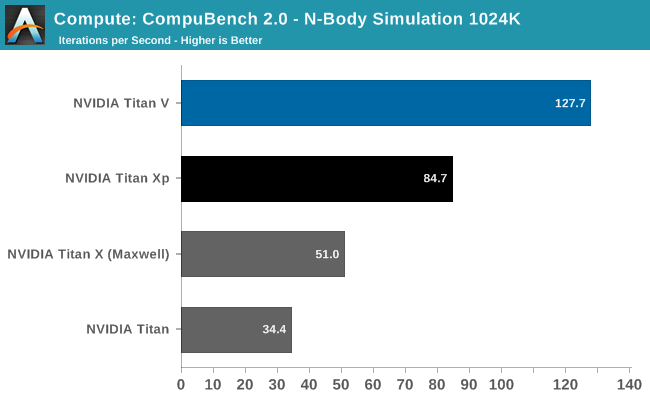The NVIDIA Titan V Preview - Titanomachy: War of the Titans
by Ryan Smith & Nate Oh on December 20, 2017 11:30 AM ESTCompute Performance: Geekbench 4
In the most recent version of its cross-platform Geekbench benchmark suite, Primate Labs added CUDA and OpenCL GPU benchmarks. This isn’t normally a test we turn to for GPUs, but for the Titan V launch it offers us another perspective on performance.

The results here are interesting. We’re not the only site to run Geekbench 4, and I’ve seen other sites with much different scores. But as we haven’t used this benchmark in great depth before, I’m hesitant to read too much into it. What it does show us, at any rate, is that the Titan V is well ahead of the Titan Xp here, more than doubling the latter’s score.
| NVIDIA Titan Cards GeekBench 4 Subscores | ||||||
| Titan V | Titan Xp | GTX Titan X | GTX Titan | |||
| Sobel (GigaPixels per second) |
35.1 | 24.9 | 16.5 | 9.4 | ||
| Histogram Equalization (GigaPixels per second) |
21.2 | 9.43 | 5.58 | 4.27 | ||
| SFFT (GFLOPS) |
180 | 136.5 | 83 | 60.3 | ||
| Gaussian Blur (GigaPixels per second) |
23.9 | 2.67 | 1.57 | 1.45 | ||
| Face Detection (Msubwindows per second) |
21.7 | 12.4 | 8.66 | 4.92 | ||
| RAW (GigaPixels per second) |
18.2 | 10.8 | 5.63 | 4.12 | ||
| Depth of Field (GigaPixels per second) |
3.31 | 2.74 | 1.35 | 0.72 | ||
| Particle Physics (FPS) |
83885 | 30344 | 18725 | 18178 | ||
Looking at the subscores, the Titan V handily outperforms the Titan Xp on all of the subtests. However it’s one test in particular that stands out here, and is likely responsible for the huge jump in the overall score, and that’s the Gaussian Blur, where the Titan V is 9x (!) faster than the Titan Xp. I am honestly not convinced that this isn’t a driver or benchmark bug of some sort, but it may very well be that Primate Labs has hit on a specific workload or scenario that sees some rather extreme benefits from the Volta architecture.
Folding @ Home
Up next we have the official Folding @ Home benchmark. Folding @ Home is the popular Stanford-backed research and distributed computing initiative that has work distributed to millions of volunteer computers over the internet, each of which is responsible for a tiny slice of a protein folding simulation. FAHBench can test both single precision and double precision floating point performance, giving us a good opportunity to let Titan V flex its FP64 muscles.

A CUDA-backed benchmark, this is the first sign that Titan V’s performance lead over the Titan Xp won’t be consistent. And more specifically that existing software and possibly even NVIDIA’s drivers aren’t well-tuned to take advantage of the Volta architecture just yet.
In this case the Titan V actually loses to the Titan Xp ever so slightly. The scores are close enough that this is within the usual 3% margin of error, which is to say that it’s a wash overall. But it goes to show that Titan V isn’t going to be an immediate win everywhere for existing software.
CompuBench
Our final set of compute benchmarks is another member of our standard compute benchmark suite: CompuBench 2.0, the latest iteration of Kishonti's GPU compute benchmark suite. CompuBench offers a wide array of different practical compute workloads, and we’ve decided to focus on level set segmentation, optical flow modeling, and N-Body physics simulations.



It’s interesting how the results here are all over the place. The Titan V shows a massive performance improvement in both N-Body simulations and Optical Flow, once again leading to the Titan V punching well above its weight. But then the Level Set Segmentation benchmark is practically tied with the Titan Xp. Suffice it to say that this puts the Titan V in a great light, and conversely makes one wonder how the Titan Xp was (apparently) so inefficient. The flip side is that it’s going to be a while until we fully understand why certain workloads seem to benefit more from Volta than other workloads.










111 Comments
View All Comments
Ryan Smith - Wednesday, December 20, 2017 - link
The "But can it run Crysis" joke started with the original Crysis in 2007. So it was only appropriate that we use it for that test. Especially since it let us do something silly like running 4x supersample anti-aliasing.crysis3? - Wednesday, December 20, 2017 - link
ahSirPerro - Wednesday, December 20, 2017 - link
They make it pretty clear everywhere this card is meant for ML training.It's the only scenario where it makes sense financially.
Gaming is a big NO at 3K dollars per card. Mining is a big NO with all the cheaper specific chips for the task.
On ML it may mean halving or cutting by 4 the training time on a workstation, and if you have it running 24/7 for hyperparameter tuning it pays itself compared to the accumulated costs of Amazon or Google cloud machines.
An SLI of titans and you train huge models under a day in a local machine. That's a great thing to have.
mode_13h - Wednesday, December 27, 2017 - link
The FP64 performance indicates it's also aimed at HPC. One has to wonder how much better it could be at each, if it didn't also have to do the other.And for multi-GPU, you really want NVlink - not SLI.
takeshi7 - Wednesday, December 20, 2017 - link
Will game developers be able to use these tensor cores to make the AI in their games smarter? That would be cool if AI shifted from the CPU to the GPU.DanNeely - Wednesday, December 20, 2017 - link
First and formost, that depends if mainstream Volta cards get tensor cores.Beyond that I'm not sure how much it'd help there directly, AFAIK what Google/etc are doing with machine learning and neural networks is very different from typical game AI.
tipoo - Wednesday, December 20, 2017 - link
They're more for training the neural nets than actually executing a games AI routine.hahmed330 - Wednesday, December 20, 2017 - link
Finally a card that can properly nail Crysis!crysis3? - Wednesday, December 20, 2017 - link
closer to 55fps if it were crysis 3 maxed outcrysis3? - Wednesday, December 20, 2017 - link
because he benchmarked the first crysis